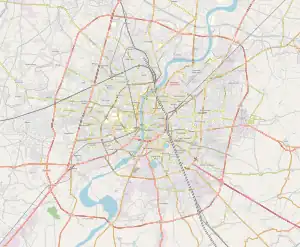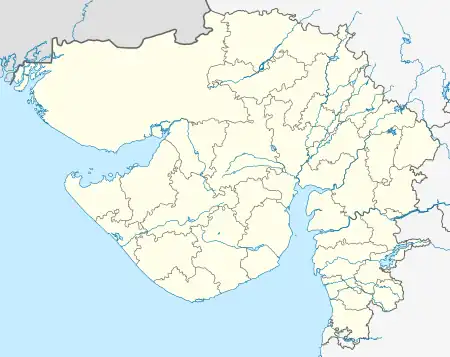Shahibaug
Shahibaug is a locality of the city of Ahmedabad.
Shahibaug
શાહીબાઘ | |
|---|---|
Suburb | |
 Shahibaug Location in Ahmedabad, Gujarat, India  Shahibaug Shahibaug (Gujarat)  Shahibaug Shahibaug (India) | |
| Coordinates: 23.058°N 72.593°E | |
| Country | |
| State | Gujarat |
| Metro | Ahmedabad |
| Government | |
| • Body | Ahmedabad Municipal Corporation |
| Elevation | 53 m (174 ft) |
| Time zone | UTC+5:30 (IST) |
| PIN | 380 004 |
| Vehicle registration | GJ-1-XX-XXXX |
| Civic agency | Ahmedabad Municipal Corporation |
History
Shahibaug or Shahibagh, or the Royal Garden palace, was built in 1622 by Shah Jahan then (1616-1622) Viceroy of Ahmedabad, to give work to the poor during a season of scarcity. The palace is now known as Moti Shahi Mahal. The Shahibaug gardens were in the seventeenth century famous, the resort of the whole city, and one of its chief ornaments. A century and a half later (1781), though the well was in ruins and the fountains and water-courses broken, the gardens could still boast of some noble cypresses, cedars, palms, sandals, and cassias, with mango, tamarind, and other spreading fruit trees. Besides the Shahi Baug gardens, there was, a little beyond, an older garden called the Andhari Badi, or dark garden, with large ruins. The palace, always kept in good repair, is thus described by Forbes in 1781:[1]
The saloon is spacious and lofty as the building; the walls are covered with a white stucco, polished like the finest marble, and the ceiling is painted in small compartments with much taste. The angular recesses lead to eight small octagon rooms, four below and as many above with separate stairs to each. They are finished in the same style as the saloon, the walls like alabaster and the ceiling embossed. The flat roof commands a wide view; the rooms under the saloon, and a surrounding platform ornamented with small canals and fountains, form a cool retreat.
To the original centre saloon, two large wings and several rooms and terraces were, about 1835, added by Mr. Williams, of the Civil Service. At a little distance from the royal mansion, on the bank of the Sabarmati river, with separate gardens, baths and fountains, was the zanana or ladies' palace. The apartments for the officers and attendants of the court were still further detached. In the great flood of 1875 the strong stone wall, which prevents the river from passing south towards the city, was slightly injured, and sand was washed over it covering and destroying the garden beds. Since this flood, along the wall the water is much deeper and tho current much stronger than it was before. In 1638 the Shahi Baug was very large, shut in by a great wall with ditches full of water. In 1666 Thevenot found the King's garden full of all kinds of trees. The road lay through an avenue like those in Paris. The garden was very large or rather there were several gardens rising like an amphitheatre. There were four wonderful walks fringed, on either side right across the garden, by a terrace full of flowers and meeting in the form of a cross, where was a great building with a roof covered with green tiles.[2]
Locality
The places of interest in Shahibaug include Miya Khan Chishti Mosque, Aiwan E Chishti Mosque, Hutheesing Jain Temple, Ahmedabad Cantonment, Camp Hanuman Temple and Calico Museum of Textiles.
Rajasthan Hospital situated in this area is one of the main hospitals of Ahmedabad. The Farki outlet of Shahibaug is known for its lassi. The Asarwa Civil Hospital is also located near Shahibaug.
Shahibaug also served as home to many famous people, including Sardar Khwaja Nasiruddin Chishty, Rabindranath Tagore, Sardar Patel, Behchar Lashkari and Bhagavatprasad Ranchoddas Family. Rabindranath Tagore stayed in the Moti Shahi Mahal in Shahibaug during his visit to Gujarat and this is where he got inspired for his short story "Hungry Stones".[3][4]
Shahibaug also includes the Gujarat circuit house which hosts most of the government guests to the city.
Schools
Schools in Shahibaug include:
- Rachana School[5]
- Earth English School
- Kendriya Vidyalaya No 1[6] - One of a series of schools in India affiliated with CBSE
- Kendriya Vidyalaya No 2 - Second Kendriya Vidyalaya school Near Hanuman Camp
- Rosery School
- Amrut High School
- The H.B.Kapadia New High School
- Aryan Gurukul
- Rajasthan Hindi High School
- [7]
Connectivity
Shahibaug is connected to Vadaj area by Subhas bridge over River Sabarmati. In 2010, a new flyover was built which now connects the 'Tran khunia bagicha' directly to the Ahmedabad cantonment area.
Politics
Shahibaug is part of the Asarwa constituency of the Gujarat Legislative Assembly and part of the Ahmedabad West constituency of the Lok Sabha.
References
- Ras Mala, 199. A Forbes' Oriental Memoir. IIL 136,138.
- Gazetteer of the Bombay Presidency: Ahmedabad (Public Domain Text). Government Central Press. 1879. p. 283.
- Datta, Rama D., ed. (2009). Celebrating Tagore. Seely, Clinton. Allied Publishers. p. 3. ISBN 978-81-8424-424-3.
- Tagore, Rabindranath. "The Hungry Stones". The Hungry Stones and Other Stories.
- "Rachana School". www.rachanaschool.com. Retrieved 28 August 2021.
- "kvshahibaug.org". ww12.kvshahibaug.org. Retrieved 28 August 2021.
- "Welcome to Rajasthan English School". www.rhhschool.org. Retrieved 29 October 2020.